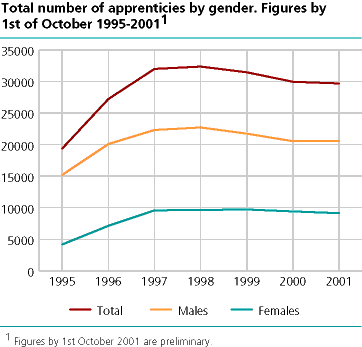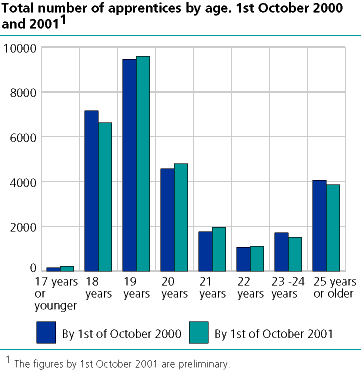Content
Published:
This is an archived release.
The number of apprentices is stable
Preliminary figures show about 29 700 apprentices in upper secondary education by 1 October 2001. This is no significant change from previous year.
1 October 2001, 29 680 apprentices were registered in upper secondary education, a reduction of about 265 from the previous year. This is the lowest decline since 1998 when the number of apprentices peaked.
Finnmark had the lowest figure with 488 apprentices, followed by Sogn og Fjordane with 851 and Aust-Agder with 880. Hordaland had most apprentices with
3 323 followed by Rogaland with 3 209. Comparatively, Oslo had a lower number of apprentices with 1 595.
Minor changes in female proportion
The proportion of female apprentices per 1 October 2001 was 30.8 per cent, a reduction of 0.6 percentage points compared with the previous year's proportion of 31.4 per cent. Sogn og Fjordane have the lowest proportion with 26 per cent, tightly followed by Akershus with 26.2 per cent. Sør-Trøndelag has the largest portion of female apprentices with 35.8 per cent and Troms with 33.7 per cent.
Unequal distribution of gender and type of education
The proportion of male apprentices within general, economics and management studies rose from 40.3 per cent in 2000 to 51.2 per cent in 2001. This is an increase of 10.9 percentage points. There was a decline in the female proportion within the male-dominated disciplines like building and construction trades, electrical trades as well as engineering and mechanical trades. Building and construction trades had the lowest proportion with only 1.2 per cent females.
The highest percentage increase of females was in agriculture, fishing and forestry, and this rose to 21.4 per cent from 16 per cent the previous year, an increase of 5.4 per cent.
Approximately 45 per cent of apprentices are over 20 years
There were 13 232 apprentices 20 years and above as at 1 October 2001. This accounts for 44.6 per cent of the total number of apprentices. The proportion of apprentices 20 years and above has not changed significantly from the school year 2000/2001 when those 20 years and above accounted for 44 per cent of the apprentices.
It is evident that there has been a decline in the number of apprentices in ages 18, 22-24 years and 25 years and above for the school year 2000/2001.
Almost half of all apprentices are new
There has been 14 416 apprentices registered in upper secondary education in the school year 2001/2002. This is 48.6 per cent of the total number of apprentices at the national level. Troms has the largest proportion with 53.6 per cent. Nordland ranks second with 52.4 per cent. Aust-Agder and Vest-Agder follow with 50.8 and 50.6 per cent respectively. Østfold has the lowest percentage of new apprentices with 45.3. Oslo falls below the national average with 47.7 per cent new apprentices.
At the national level, females comprise 31.3 per cent of new apprentices. Akershus has the lowest proportion with 27.3 per cent. This is followed by Oslo with 28.1 per cent. Sør-Trøndelag has the largest female proportion of new apprentices with 35.6 per cent. Sør- Trøndelag also has the largest female proportion of the total number of apprentices both old and new with 35.8 per cent.
Finnmark has most new apprentices 25 years and above
Finnmark has the largest portion of matured new apprentices with 25.8 per cent. The national average for new apprentices 25 years and above is 10.8 per cent. Troms has a relatively large portion of new apprentices within this age group with 17.7 per cent. This is followed by Nord-Trøndelag with 17.3 per cent. Oppland has the lowest proportion of new apprentices 25 years and above with only 5.6 per cent. Oslo has 13.5 per cent and falls below the national average within this age group.
High rate of failure in technical building trades
20 817 candidates sat for apprenticeship examinations between 1 October 2000 and 30 September 2001. About 92.9 per cent passed the apprenticeship examinations. The highest per cent of candidates who failed was within technical building trades with 14.1. This is followed by arts, crafts and designs with 13.6 per cent. Chemical and processing trades had the lowest proportion of candidates who failed with 1.9 per cent.
Large portion of practice candidates passed vocational examinations
Out of the 20 817 candidates who sat for the vocational examinations between 1 October 2000 and 30 September 2001, 7 459 representing 35.8 per cent were practice candidates. 96 per cent of the practise candidates passed. Apprentices followed with 92 per cent while pupils in alternative upper secondary courses registered the lowest pass rate with 70 per cent.
The statistics are published annually.
Tables:
- Table 1 Apprentices, by gender and type of education. Preliminary figures. 1st October 2001
- Table 2 Apprentices, by gender and county of residence. Preliminary figures. 1st October 2001
- Table 3 Apprentices by age and county of residence. Preliminary figures. 1st October 2001
- Table 4 Apprentices by category and county of residence. Preliminary figures 1st October 2000-30th September 2001
- Table 5 New apprentices by gender and county of residence. Preliminary figures. 1st October 2000-30th September 2001
- Table 6 New apprentices, by age and county of residence. Preliminary figures. 1st October 2000-30th September 2001
- Table 7 Vocational examination candidates by gender, type of education and results. Preliminary figures. 1st October 2000-30th September 2001
- Table 8 Candidates who passed a vocational examination by gender and county of residence. 1st October 2000 - 30th September 2001
- Table 9 Candidates who passed a vocational examination by age and county of residence. 1st October 2000-30th September 2001
- Table 10 Vocational examinations by category and results. Preliminary figures 1st October 2000-30th September 2001
The statistics is published with Upper secondary education.
Contact
-
Statistics Norway's Information Centre
E-mail: informasjon@ssb.no
tel.: (+47) 21 09 46 42


